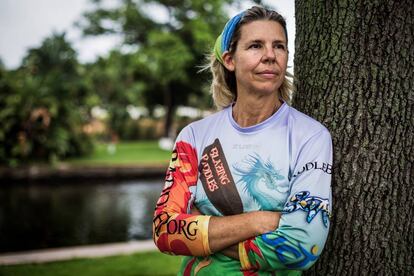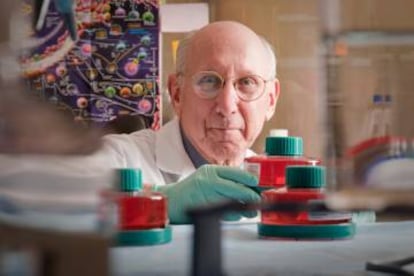Woman’s cancer recovery brings fresh hope of medical breakthrough
After US success, Spanish researchers will conduct similar trials to test new immunotherapy method

In 2014, Judy Perkins was suffering from a metastatic breast cancer that had spread to her liver and other organs. Doctors told the 49-year-old engineer from Florida that she had two months left to live. Yet nearly four years later, she is still alive and cancer-free thanks to an experimental treatment involving an infusion of her own immune-system cells. Her story provides hope that medicine will develop a new kind of immunotherapy to fight the most lethal forms of cancer.
Either there is a radical change or this type of treatment will only be available to an elite
Manuel Ramírez-Orellana, researcher
“We have seen five patients with spectacular regressions such as this one, including another woman with metastatic colon cancer who has been disease-free for nearly five years,” explains Steven Rosenberg, a surgeon at the National Cancer Institute in the US and the creator of this experimental therapy.
“This technique is still in its infancy. We are working tirelessly to improve its effectiveness, because for now only 15% of patients are responding,” warns Rosenberg, 78, speaking on the phone from his office in Bethesda, Maryland.
Trials in Spain
In Pamplona, Madrid and Barcelona, doctors are going to test a slightly less specific technique on patients with melanoma and cervical cancer. In this case, lymphocytes are extracted from the patient, frozen and sent to a US company named Iovance Biotherapeutics, where they are grown to large numbers and sent back to the hospital. Unlike the US trials, in this case there is no specific selection of immune-system cells that recognize the tumor’s antigens, making the treatment less targeted.
“This technique sounded like science fiction just two years ago, but there’s been a huge leap in the development of the technology required to isolate, cultivate and sequence the lymphocytes’ genome,” explains Ignacio Melero, an immunology specialist at the Navarre University Clinic and the CIMA medical center. “Even though it is still early and we don’t have definitive proof that it is effective, it has enormous potential.”
An army of T-cells
The most interesting part about the isolated success stories in the US is that patients were suffering from metastatic epithelial tumors that had spread to other parts of their body. This causes 90% of all cancer deaths and there is no effective treatment against them.

“These results give us hope of finding a strategy to treat epithelial tumors, for instance of the liver, colon, cervical, breast and others,” said Rosenberg.
The new technique uses tumor-infiltrating lymphocytes (TIL) and it is a new form of immunotherapy currently at the trial stage. There are already drugs on the market based on antibodies that stick to the lymphocytes in order to destroy tumor cells. This kind of immunotherapy is effective against metastatic melanoma and advanced lung cancer, although it only works on around a third of patients for reasons that remain unclear.
The TIL treatment is designed to combat tumors that have not responded well to other forms of immunotherapy. The technique isolates a type of lymphocyte known as T-cells that have penetrated the tumor, and selects those that are capable of identifying cancer mutations. In Perkins’ case, doctors isolated just 11 lymphocytes, and from these they obtained 80 billion more that were infused back into the patient. A year later, all the tumors had disappeared.
The bad news
Because identified mutations are specific to each patient, a unique treatment has to be developed for each case. This entails massive genetic sequencing and the work of around 30 specialists. The cost of approved existing CAR-T drugs is around €400,000, and the new TIL treatment could be upwards of that.
This technique sounded like science fiction just two years ago
Ignacio Melero, Navarre University Clinic
This means that there is a possibility of developing new therapies against the most lethal tumors, but few people will be able to afford them, several oncologists have admitted.
“In a way, it would be very positive to reach the point where we have this problem,” says Alena Gros, head of the Tumor Immunotherapy and Immunology Group at the Vall d’Hebron Oncology Institute in Barcelona. “The market and the healthcare system would have to be regulated on the basis of need and effectiveness so that patients could access it. This has already happened with other cell-based therapies such as CAR anti-CD19, where the therapy is only paid for if the patient responds. But for now we are still far from having to face this dilemma.”
Gros met Judy Perkins and other patients who were cured of their cancer between 2014 and 2016, when she spent time at Rosenberg’s lab to learn the TIL technique. Now she intends to conduct a clinical trial in Spain, although it could be another year or two before it gets underway.
In Madrid, a team led by Manuel Ramírez-Orellana tested the TIL treatment on four children with unresponsive tumors at Hospital Niño Jesús. “We saw that the treatment was safe, but the patients did not respond,” says Ramírez-Orellana, who is currently at the Children’s Hospital in Seattle to learn T-cell engineering.
This researcher believes that the best strategy will involve a combination of therapies. “The TIL therapy requires facilities that are expensive to build and maintain, but which already exist at some Spanish public hospitals,” he says.
“The whole parallel research program requires resources that are very difficult to obtain,” Ramírez-Orellana explains. “The price of CAR-T treatments is exorbitant. It’s absurd, because the public healthcare system cannot afford it, in fact many private systems can’t, either. Either there is a radical change or this type of treatment will only be available to an elite.”
But Rosenberg is sure that if the treatment proves effective, “the pharmaceutical industry will take care to make it possible and affordable. There are at least three companies that are already exploring commercial development.”
English version by Susana Urra.
Tu suscripción se está usando en otro dispositivo
¿Quieres añadir otro usuario a tu suscripción?
Si continúas leyendo en este dispositivo, no se podrá leer en el otro.
FlechaTu suscripción se está usando en otro dispositivo y solo puedes acceder a EL PAÍS desde un dispositivo a la vez.
Si quieres compartir tu cuenta, cambia tu suscripción a la modalidad Premium, así podrás añadir otro usuario. Cada uno accederá con su propia cuenta de email, lo que os permitirá personalizar vuestra experiencia en EL PAÍS.
¿Tienes una suscripción de empresa? Accede aquí para contratar más cuentas.
En el caso de no saber quién está usando tu cuenta, te recomendamos cambiar tu contraseña aquí.
Si decides continuar compartiendo tu cuenta, este mensaje se mostrará en tu dispositivo y en el de la otra persona que está usando tu cuenta de forma indefinida, afectando a tu experiencia de lectura. Puedes consultar aquí los términos y condiciones de la suscripción digital.
More information
Archived In
Últimas noticias
Most viewed
- Reinhard Genzel, Nobel laureate in physics: ‘One-minute videos will never give you the truth’
- Oona Chaplin: ‘I told James Cameron that I was living in a treehouse and starting a permaculture project with a friend’
- Pablo Escobar’s hippos: A serious environmental problem, 40 years on
- Why we lost the habit of sleeping in two segments and how that changed our sense of time
- Chevy Chase, the beloved comedian who was a monster off camera: ‘Not everyone hated him, just the people who’ve worked with him’











































